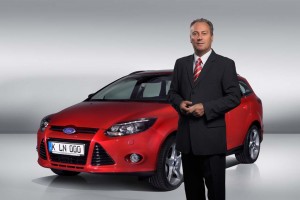With the European automotive market showing signs of an upturn after its worst slump in a quarter century, Ford Motor Co. is growing increasingly confident in the aggressive turnaround plan it launched during the depths of the downturn.
The maker’s sales have been outpacing the overall industry recovery, and while some automotive analysts believe Ford of Europe might actually break even for 2014 the maker is, for now, sticking with guidance promising to “improve” its financial situation this year, while projecting “profitability” in 2015. Ford lost $1.4 billion in Europe last year.
The plan is “on track,” said Ford of Europe president Stephen Odell, during a media roundtable on Thursday. “We are very, very pleased with where we are in our European transformation plan.”
That’s a much better assessment of the situation than Ford has had in recent years, following the unexpectedly deep hole the European car market plunged into. While things didn’t tumble quite so precipitously as in the U.S., the Continental collapse dragged out far longer, sales last year dipping to a decade’s low 13.5 million, off from a pre-recession peak of about 17.5 million.
(Ford joins the recall blitz with six new service actions. Click Here for more.)
And the decline in sales was worsened by a long-running issue with excess capacity that made it difficult for manufacturers to make money even in the best of times. But a mix of competitive strategies, government regulations – and, some would argue, egos – made it difficult for the industry to make the necessary cuts. Only a handful of manufacturers have bitten the bullet, closing unneeded factories.
Ford, in fact, will have closed three component and assembly plants by the time its line in Genk, Belgium is shuttered at the end of the year, all told, the maker taking out about 350,000 units of capacity.
Meanwhile, it has negotiated a new contract with German workers that should yield $470 million in savings over several years.
But, as the old adage goes, you can’t cost-cut your way to prosperity, and Ford is putting even more stock in turning things around with a blitz that will bring “at least 25 new products” to the European market in a five-year period. That covers everything from major updates of the compact Focus and midsize Mondeo models to all-new commercial vans, the Transit and Transit Connect.
(Ford sales soar in China. Click Herefor the latest.)
Ford also will launch a version of the new 2015 Mustang in Europe for the first time. Anticipation has been so strong for the “pony car” that when the maker opened an online order center earlier this year, all 500 initial models were snapped up “within 30 seconds,” Odell boasted.
While the product offensive is just beginning, the bigger payoff likely in 2015, Odell noted that Ford of Europe’s sales surged 6.6% during the first half of 2014, a modest bit ahead of the industry’s overall 6.3% increase. June’s sales of 605,400 vehicles helped the company reach its highest level for the first six months since 2011.
If anything, Odell suggested Ford is restraining its potential growth by not taking the sort of aggressive pricing and marketing actions – such as dumping cars into fleets – that could further boost sales and market share.
“We are taking the actions we think are necessary to have sustainable profits in Europe,” he emphasized.
That said, the British-born Odell cautioned that “The pricing environment in Europe remain extremely competitive,” which translates into constrained profitability, even as the market recovers on a volume standpoint.
As a result, Ford has high hopes for boosting transaction prices with the upcoming launch of its new premium Vignale models. More upscale than existing Fords, such as the Mondeo sedan, Vignale models are meant to intercept buyers who might be thinking about a move from mainstream marques to more premium brands like BMW or Mercedes-Benz.
(New Ford CEO Mark Fields fares well with $5 mil pay package. Click Here for more.)
While Europe may be showing signs of recovery after a bleak six years, Odell was cautious when asked whether the worst is over. He noted that there are still a number of problems that are inhibiting a true recovery, suggesting “the biggest inhibitor is employment levels.” Even in relatively healthy Germany, unemployment currently averages about 6.3%, while the number is closer to 25% in Spain. And a third of Europeans under the age of 35 are without work.
Nonetheless, said Odell, “We are much happier to be where we are this year because we were at the trough last year.”

